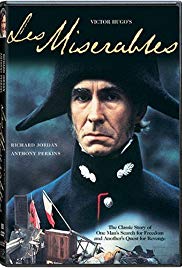These films tell parts of Victor Hugo’s epic novel of poverty, crime, redemption, romantic love and revolution in France in the early 19th century. The 1978 film develops the characters of Jean Valjean and Javert in an excellent fashion. The 1998 film version is beautiful and well made with some powerful performances. This version tracks the novel in most respects but has unnecessary moderately graphic violence and offensive scenes showing nudity and the life of a prostitute. In addition, the characters of Valjean and Javert are not developed as clearly as in 1978 made for TV version. For a discussion of the 1995 film version, see Notes on Movies For Which a Learning Guide has not been Prepared.
1978 Made for Television Version
Selected Awards:
None.
Featured Actors:
Richard Jordan, Anthony Perkins, Cyril Cusack, Claude Dauphin, John Geilgud, Ian Holme, Celia Johnson.
Director:
Glenn Jordan.
1998 Film Version
Selected Awards:
None.
Featured Actors:
Liam Neeson as Jean Valjean; Geoffrey Rush as Inspector Javert; Uma Thurman as Fantine; Claire Danes as Cosette; Hans Matheson as Marius; Reine Brynolfsson as Captain Beauvais; Peter Vaughan as Bishop.
Director:
Billie August.
These films will acquaint children with this epic story and with its characters who have become archetypes: Jean Valjean, a man condemned by poverty and classification as a convicted felon but redeemed by the kindness of one man and his own will; Cosette, the child victim of poverty; Bishop Myriel, the social activist who believes in the essential goodness of man; and Javert, the petty, regulation-bound, and shortsighted bureaucrat who relentlessly and unreasonably pursues a good man for a violation that should have been forgotten long ago.
MINOR. Javert commits suicide. We see him jump into the Seine.
Ask and help your child to answer the Quick Discussion Question. Then ask them to compare two characters in the movie: Inspector Javert and the priest who helped Jean Valjean. One is a brittle man who sticks to the letter of the law even if injustice will result. The other is a forgiving man who looks for the best in human character and tries to help out.
This novel takes place in France in which the monarchy has been returned to power by the reactionary forces of Europe that defeated Napoleon in 1815. In the France of the Restoration, the disparity between the wealth of the aristocracy and the desperate poverty of the masses is overwhelming.
Hugo said of Les Misérables:
So long as there exist, by reason of law and custom, a social condemnation which, in the midst of civilization, artificially creates a hell on earth, and complicates with human fatality a destiny that is divine; so long as the three problems of the century – the degradation of man by the exploitation of his labor, the ruin of woman by starvation, and the atrophy of childhood in physical and spiritual night – are not solved; … in other words, and from a still broader point of view, so long as ignorance and misery remain on earth, there should be a need for books such as this.
1. See Discussion Questions for Use With any Film that is a Work of Fiction.
2. Read the quote from Hugo in the Historical Background section. Do the ills that he describes still exist in our society? Are stories like Les Misérables still necessary?
3. Why did Jean Valjean spare Javert’s life?
4. Do you think that Cosette and Marius knew each other well enough to really fall in love? What chances do you give them for long term happiness together?
REDEMPTION
1. How would you react to an ex-convict who had spent many years in the harshest and roughest prisons, living and working close to you? What if you had young children?
2. What did Jean Valjean do to redeem himself?
SUICIDE
3. Describe the character of Javert and tell us: Why he let Jean Valjean go? Why he committed suicide? What should he have done instead?
Discussion Questions Relating to Ethical Issues will facilitate the use of this film to teach ethical principles and critical viewing. Additional questions are set out below.
FAIRNESS
(Play by the rules; Take turns and share; Be open-minded; listen to others; Don’t take advantage of others; Don’t blame others carelessly)
1. Did Jean Valjean do wrong by trying to escape from the galleys? Do you blame him for trying to escape? If you don’t blame him for trying to escape, where do you draw the line between crime which should be punished and crime that can be excused?
2. Did Jean Valjean do wrong by stealing the silver from the Bishop? Do you blame him for doing it? If you don’t blame him for stealing the silver, where do you draw the line between crime which should be punished and crime that can be excused?
3. Did Jean Valjean do wrong by stealing the coin from Petit Gervais? Do you blame him for doing it? If you don’t blame him for stealing the coin, where do you draw the line between crime which should be punished and crime that can be excused?
CARING
(Be kind; Be compassionate and show you care; Express gratitude; Forgive others; Help people in need)
4. Who in this film is the most compassionate? How does this story illustrate the tremendous power of compassion to do good?
Children should be encouraged to read this book as soon as they are able to handle it.
This Learning Guide was last updated on April 8, 2010.


